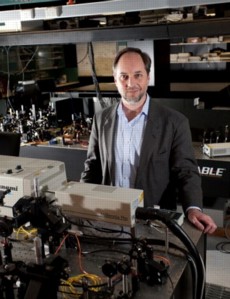Home > Press > Squeeze light till it hurts on a quantum scale
 |
| Professor Howard Wiseman |
Abstract:
An international team of physicists has pushed the boundaries on ultra-precise measurement by harnessing quantum light waves in a new way.
Squeeze light till it hurts on a quantum scale
Brisbane, Australia | Posted on September 24th, 2012It is one thing to be able to measure spectacularly small distances using "squeezed" light, but it is now possible to do this even while the target is moving around.
An Australian-Japanese research collaboration made the breakthrough in an experiment conducted at the University of Tokyo, the results of which have been published in an article, "Quantum-enhanced optical phase tracking" in the prestigious journal, Science.
Leader of the international theoretical team Professor Howard Wiseman, from Griffith University's Centre for Quantum Dynamics (pictured), said this more precise technique for motion tracking will have many applications in a world which is constantly seeking smaller, better and faster technology.
"At the heart of all scientific endeavour is the necessity to be able to measure things precisely," Professor Wiseman said.
"Because the phase of a light beam changes whenever it passes through or bounces off an object, being able to measure that change is a very powerful tool."
"By using squeezed light we have broken the standard limits for precision phase tracking, making a fundamental contribution to science," he said. "But we have also shown that too much squeezing can actually hurt."
Dr Dominic Berry from Macquarie University has been collaborating with Professor Wiseman on the theory of this problem for many years.
"The key to this experiment has been to combine "phase squeezing" of light waves with feedback control to track a moving phase better than previously possible," Dr Berry said.
"Ultra-precise quantum-enhanced measurement has been done before, but only with very small phase changes. Now we have shown we can track large phase changes as well," he said.
Professor Elanor Huntington from UNSW Canberra, who directed the Australian experimental contribution, is a colleague of Professor Wiseman in the Centre for Quantum Computation and Communication Technology.
"By using quantum states of light we made a more precise measurement than is possible through the conventional techniques using laser beams of the same intensity," Professor Huntington said.
"Curiously, we found that it is possible to have too much of a good thing. Squeezing beyond a certain point actually degrades the performance of the measurement, making it less precise than if we had used light with no squeezing."
Participating research organisations: The University of Tokyo, Griffith University, Centre for Quantum Computation and Communication Technology (Australian Research Council), University of New South Wales (Canberra), Kyoto University, University of Waterloo (Ontario), Macquarie University, University of Queensland.
####
For more information, please click here
Contacts:
Professor Howard Wiseman
Director
Centre Staff
Centre for Quantum Dynamics
Telephone 61 (07) 373 57279
Fax 61 (07) 373 57773
Copyright © Griffith University
If you have a comment, please Contact us.Issuers of news releases, not 7th Wave, Inc. or Nanotechnology Now, are solely responsible for the accuracy of the content.
| Related News Press |
News and information
![]() Researchers develop molecular qubits that communicate at telecom frequencies October 3rd, 2025
Researchers develop molecular qubits that communicate at telecom frequencies October 3rd, 2025
![]() Next-generation quantum communication October 3rd, 2025
Next-generation quantum communication October 3rd, 2025
![]() "Nanoreactor" cage uses visible light for catalytic and ultra-selective cross-cycloadditions October 3rd, 2025
"Nanoreactor" cage uses visible light for catalytic and ultra-selective cross-cycloadditions October 3rd, 2025
Discoveries
![]() Researchers develop molecular qubits that communicate at telecom frequencies October 3rd, 2025
Researchers develop molecular qubits that communicate at telecom frequencies October 3rd, 2025
![]() Next-generation quantum communication October 3rd, 2025
Next-generation quantum communication October 3rd, 2025
![]() "Nanoreactor" cage uses visible light for catalytic and ultra-selective cross-cycloadditions October 3rd, 2025
"Nanoreactor" cage uses visible light for catalytic and ultra-selective cross-cycloadditions October 3rd, 2025
Announcements
![]() Rice membrane extracts lithium from brines with greater speed, less waste October 3rd, 2025
Rice membrane extracts lithium from brines with greater speed, less waste October 3rd, 2025
![]() Researchers develop molecular qubits that communicate at telecom frequencies October 3rd, 2025
Researchers develop molecular qubits that communicate at telecom frequencies October 3rd, 2025
![]() Next-generation quantum communication October 3rd, 2025
Next-generation quantum communication October 3rd, 2025
![]() "Nanoreactor" cage uses visible light for catalytic and ultra-selective cross-cycloadditions October 3rd, 2025
"Nanoreactor" cage uses visible light for catalytic and ultra-selective cross-cycloadditions October 3rd, 2025
Photonics/Optics/Lasers
![]() ICFO researchers overcome long-standing bottleneck in single photon detection with twisted 2D materials August 8th, 2025
ICFO researchers overcome long-standing bottleneck in single photon detection with twisted 2D materials August 8th, 2025
![]() Institute for Nanoscience hosts annual proposal planning meeting May 16th, 2025
Institute for Nanoscience hosts annual proposal planning meeting May 16th, 2025
Research partnerships
![]() Lab to industry: InSe wafer-scale breakthrough for future electronics August 8th, 2025
Lab to industry: InSe wafer-scale breakthrough for future electronics August 8th, 2025
![]() HKU physicists uncover hidden order in the quantum world through deconfined quantum critical points April 25th, 2025
HKU physicists uncover hidden order in the quantum world through deconfined quantum critical points April 25th, 2025
Quantum nanoscience
![]() ICFO researchers overcome long-standing bottleneck in single photon detection with twisted 2D materials August 8th, 2025
ICFO researchers overcome long-standing bottleneck in single photon detection with twisted 2D materials August 8th, 2025
![]() Programmable electron-induced color router array May 14th, 2025
Programmable electron-induced color router array May 14th, 2025
|
|
||
|
|
||
| The latest news from around the world, FREE | ||
|
|
||
|
|
||
| Premium Products | ||
|
|
||
|
Only the news you want to read!
Learn More |
||
|
|
||
|
Full-service, expert consulting
Learn More |
||
|
|
||








